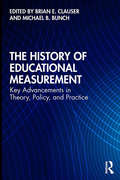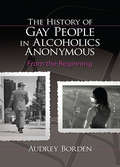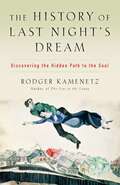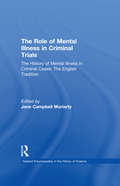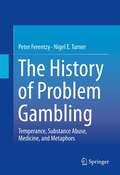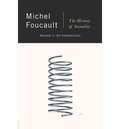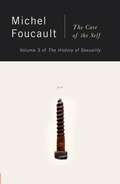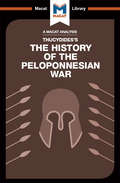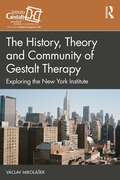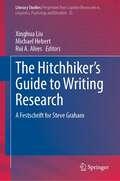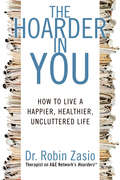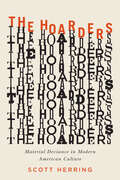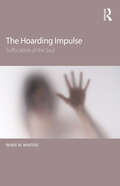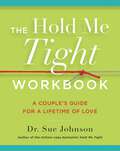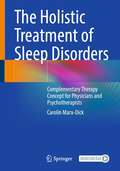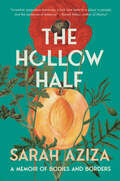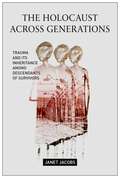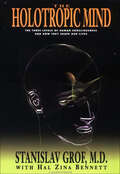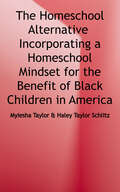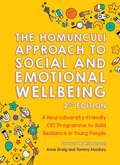- Table View
- List View
The History of Educational Measurement: Key Advancements in Theory, Policy, and Practice
by Brian E. ClauserThe History of Educational Measurement collects essays on the most important topics in educational testing, measurement, and psychometrics. Authored by the field’s top scholars, this book offers unique historical viewpoints, from origins to modern applications, of formal testing programs and mental measurement theories. Topics as varied as large-scale testing, validity, item-response theory, federal involvement, and notable assessment controversies complete a survey of the field’s greatest challenges and most important achievements. Graduate students, researchers, industry professionals, and other stakeholders will find this volume relevant for years to come.
The History of Educational Measurement: Key Advancements in Theory, Policy, and Practice
by Brian E. ClauserThe History of Educational Measurement collects essays on the most important topics in educational testing, measurement, and psychometrics. Authored by the field’s top scholars, this book offers unique historical viewpoints, from origins to modern applications, of formal testing programs and mental measurement theories. Topics as varied as large-scale testing, validity, item-response theory, federal involvement, and notable assessment controversies complete a survey of the field’s greatest challenges and most important achievements. Graduate students, researchers, industry professionals, and other stakeholders will find this volume relevant for years to come.
The History of Gay People in Alcoholics Anonymous: From the Beginning
by Audrey BordenThe History of Gay People in Alcoholics Anonymous documents and honors the ways thousands of LGBT people have carried Alcoholics Anonymous' message. This illuminating chronicle includes interviews and documents that detail the compelling history, recovery, and wisdom of gay people in AA. The book examines the challenges AA faced as the fellowship endeavored to become a more inclusive and cohesive community. The first-person accounts narrate the important work of influential gay and straight AA members that led key events in AA’s history. The author includes material on the steps and traditions of AA, and on becoming an ally to LGBT people on the road to recovery.Topics in The History of Gay People in Alcoholics Anonymous include: the gay origins of AA’s Third Tradition a comparison of treatments for alcoholism and homosexuality compelling portraits of sober gay life in the 1950s and 1960s the debate in AA over meetings for gay alcoholics interviews with members and co-founders of the first gay AA meetings the history of the first gay AA/Al-Anon conference interviews with pioneering gay addiction professionals the history of AA pamphlet “AA and the Gay/Lesbian Alcoholic” Alcoholics Together, and why a parallel AA organization for gay alcoholics formed in southern California strategies AA’s gay members developed to make their meetings simultaneously safe and public—and why some of them are still necessary today much more The History of Gay People in Alcoholics Anonymous is an enlightening book for members of the LGBT and heterosexual recovering community, alcoholism and addiction professionals, as well as physicians, counselors, psychiatrists, psychologists, social workers, clergy, historians, sociologists, educators, students, and anyone interested in learning more about AA or this aspect of the community’s history.
The History of Last Night's Dream: Discovering the Hidden Path to the Soul
by Rodger KamenetzOur Dreams Will Never Be the Same AgainInternational bestselling author Rodger Kamenetz believes it is not too late to reclaim the lost power of our nightly visions. He fearlessly delves into this mysterious inner realm and shows us that dreams are not only intensely meaningful, but hold essential truths about who we are. In the end, each of us has the choice to embark on this illuminating path to the soul.
The History of Mental Illness in Criminal Cases: The Role of Mental Illness in Criminal Trials (Garland Encyclopedias in the History of Science)
by Jane Campbell MoriartyFirst Published in 2002. Routledge is an imprint of Taylor & Francis, an informa company.
The History of Problem Gambling
by Nigel E. Turner Peter FerentzyThis book documents the history of ideas about problem gambling and its link to addictive disorders. The book uses a combination of literature review and conceptual and linguistic analysis to explore the way ideas about problem gambling gave changed over time. It examines the religious, socio-cultural, and medical influences on the development of the concept of problem gambling as a disease, along with the ways in which such ideas were influenced by attitudes about substance abuse. The history of mental illness, notably as it pertains to themes such as loss of control over behavior, is also addressed. The book ends with a discussion of the current status and future prospects, with an eye to which ideas about problem gambling and addictions seem most promising and which should perhaps be left behind.
The History of Sexuality, Vol. 1: An Introduction
by Michel FoucaultDiscusses the social construction of sexuality.
The History of Sexuality, Vol. 3: The Care of the Self
by Michel Foucault Robert HurleyThe Care of the Self is the third and possibly final volume of Michel Foucault's widely acclaimed examination of "the experience of sexuality in Western society." Foucault takes us into the first two centuries of our own era, into the Golden Age of Rome, to reveal a subtle but decisive break from the classical Greek vision of sexual pleasure. He skillfully explores the whole corpus of moral reflection among philosophers (Plutarch, Epictetus, Marcus Aurelius, Seneca) and physicians of the era, and uncovers an increasing mistrust of pleasure and growing anxiety over sexual activity and its consequences.
The History of the Peloponnesian War
by Mark FisherFew works can claim to form the foundation stones of one entire academic discipline, let alone two, but Thucydides's celebrated History of the Peloponnesian War is not only one of the first great works of history, but also the departure point from which the modern discipline of international relations has been built. This is the case largely because the author is a master of analysis; setting out with the aim of giving a clear, well-reasoned account of one of the seminal events of the age – a war that resulted in the collapse of Athenian power and the rise of Sparta – Thucydides took care to build a single, beautifully-structured argument that was faithful to chronology and took remarkably few liberties with the source materials. He avoided the sort of assumptions that make earlier works frustrating for modern scholars, for example seeking reasons for outcomes that were rooted in human actions and agency, not in the will of the gods. And he was careful to explain where he had obtained much of his information. As a work of structure – and as a work of reasoning – The History of the Peloponnesian War continues to inspire, be read and be taught more than 2,000 years after it was written.
The History, Theory and Community of Gestalt Therapy: Exploring the New York Institute (Gestalt Therapy Book Series)
by Václav MikolášekThis book tells the story of the community at the New York Institute for Gestalt Therapy (NYIGT) as it evolved in connection with the highly regarded theory it produced, examining some important turning points for the institute spanning the period from the early 1970s until 2020 and describing the more large-scale changes the community underwent. Through chronologically ordered chapters, the history of the NYIGT is written in a documentary-style narrative complete with the voices of contemporary witnesses embedded into the storyline. The book explores the aggressiveness during community meetings that the institute was once known for, how the LGBTQIA community shaped the institute from the beginning, what changed when the institute began to be run democratically, its feminist revolution, as well as recent developments and the institute’s current group processes. This historically rich work is essential reading for Gestalt therapists, other professionals interested in Gestalt approaches, and readers interested in the history of Gestalt therapy.
The Hitchhiker's Guide to Writing Research: A Festschrift for Steve Graham (Literacy Studies #25)
by Xinghua Liu Michael Hebert Rui A. AlvesThis book brings together the work of established scholars from around the world to celebrate and honor the many ways in which Steve Graham has contributed to the advancement of teaching and researching writing. Focusing on writing development and writing instruction in different contexts of education, original contributions in this book critically engage with theoretical and empirical issues raised in Steve Graham’s influential body of work and significantly extend our understandings of the importance of writing in developing learners’ literacy and the roles of writing in teaching and learning processes.This book is organized around themes central to Steve Graham's work, including theories and models of writing, effective instructional methods in teaching writing, surveys on teaching and learning writing, and systematic review studies on writing. Apart from regular chapters, the book also features personal and scholarly reflections revealing the powerful ways in which Steve Graham’s work has influenced our thinking in the field of writing research and continues to open up new avenues for future research endeavors.
The Hoarder in You: How to Live a Happier, Healthier, Uncluttered Life
by Robin ZasioWe all have treasured possessions—a favorite pair of shoes, a much-beloved chair, an ever-expanding record collection. But sometimes, this emotional attachment to our belongings can spiral out of control and culminate into a condition called compulsive hoarding. From hobbyists and collectors to pack rats and compulsive shoppers—it is close to impossible for hoarders to relinquish their precious objects, even if it means that stuff takes over their lives and their homes. According to psychologist Dr. Robin Zasio, our fascination with hoarding stems from the fact that most of us fall somewhere on the hoarding continuum. Even though it may not regularly interfere with our everyday lives, to some degree or another, many of us hoard. The Hoarder In You provides practical advice for decluttering and organizing, including how to tame the emotional pull of acquiring additional things, make order out of chaos by getting a handle on clutter, and create an organizational system that reduces stress and anxiety. Dr. Zasio also shares some of the most serious cases of hoarding that she's encountered, and explains how we can learn from these extreme examples—no matter where we are on the hoarding continuum.
The Hoarders: Material Deviance in Modern American Culture
by Scott HerringThe verb “declutter” has not yet made it into the Oxford English Dictionary, but its ever-increasing usage suggests that it’s only a matter of time. Articles containing tips and tricks on how to get organized cover magazine pages and pop up in TV programs and commercials, while clutter professionals and specialists referred to as “clutterologists” are just a phone call away. Everywhere the sentiment is the same: clutter is bad. In The Hoarders, Scott Herring provides an in-depth examination of how modern hoarders came into being, from their onset in the late 1930s to the present day. He finds that both the idea of organization and the role of the clutterologist are deeply ingrained in our culture, and that there is a fine line between clutter and deviance in America. Herring introduces us to Jill, whose countertops are piled high with decaying food and whose cabinets are overrun with purchases, while the fly strips hanging from her ceiling are arguably more fly than strip. When Jill spots a decomposing pumpkin about to be jettisoned, she stops, seeing in the rotting, squalid vegetable a special treasure. “I’ve never seen one quite like this before,” she says, and looks to see if any seeds remain. It is from moments like these that Herring builds his questions: What counts as an acceptable material life—and who decides? Is hoarding some sort of inherent deviation of the mind, or a recent historical phenomenon grounded in changing material cultures? Herring opts for the latter, explaining that hoarders attract attention not because they are mentally ill but because they challenge normal modes of material relations. Piled high with detailed and, at times, disturbing descriptions of uncleanliness, The Hoarders delivers a sweeping and fascinating history of hoarding that will cause us all to reconsider how we view these accumulators of clutter.
The Hoarding Impulse: Suffocation of the Soul
by Renee M. WintersThere has been an increased awareness of hoarding in recent years, but clinical treatments aimed at helping people with this condition often have low success rates. In The Hoarding Impulse Renee M. Winters explores how depth psychology can enrich current conceptual models and treatment standards for compulsive hoarding. The book presents case studies of prominent sufferers including Edie and Edith Beale, the Collyer Brothers, and Andy Warhol and explores common themes of loss, shame and object clusters. Winters sets out to provide a clear understanding of a hoarder’s lived experiences and their core schemas of value, worth and personal identity, revealing a direct connection to excessive acquisition of objects. She illuminates the process of how objects can come to possess a hoarder and become not only their main source of happiness but also part of their identity and in doing so puts forward a new treatment plan based on providing a deeper understanding of and potent treatment approach to what is a core issue for hoarding individuals: the wounding of the soul. This new perspective to treating individuals who hoard helps them in the long term understand their processes, value system, and struggles with negative interpersonal relationships. Providing a fascinating insight into the psyche of people who struggle with hoarding, this book will be essential reading for depth psychologists, Jungian psychotherapists, psychiatrists, social workers, students of analytical psychology and anyone interested in understanding the dynamics of this complex condition.
The Hold Me Tight Workbook: A Couple's Guide for a Lifetime of Love (The Dr. Sue Johnson Collection #4)
by Dr. Sue JohnsonA companion workbook to Dr. Sue Johnson&’s million-copy bestseller Hold Me Tight, packed with exercises, conversation prompts, and activities to help couples strengthen their bond, deepen their intimacy, and cultivate a lifetime of love. Dr. Sue Johnson's landmark book Hold Me Tight has helped more than 1 million readers strengthen and repair their romantic relationships. Now, finally, comes a companion workbook designed to help couples open up, reestablish safe emotional connection, and renew their bond. Drawing on the latest developments in Emotionally Focused Therapy, a field pioneered by Dr. Johnson, The Hold Me Tight Workbook is packed with sage wisdom and science-backed advice, as well as compelling conversation prompts, exercises, activities, and resources to help couples work through conflict and achieve greater levels of intimacy. Whether you're celebrating your 50th anniversary or your first, The Hold Me Tight Workbook is an invaluable guide to cultivating a deeper connection — and more fulfilling relationship — with the person you love most.
The Holistic Treatment of Sleep Disorders: Complementary Therapy Concept for Physicians and Psychotherapists
by Carolin Marx-DickThe book conveys a complete holistic therapy concept for the treatment of sleep disorders. Starting from the knowledge transfer on the functions of sleep and evident consequences of sleep disorders, Carolin Marx-Dick describes the multimodal treatment according to the concept of mind-body medicine with the help of compact and well-tested instructions for action. This includes mindfulness-based therapy techniques, body therapy elements, nutrition and exercise therapy as well as naturopathic treatment approaches. Work and patient materials are provided for download, enabling a straightforward and short-term application of the therapy methods. Overview tables provide the practitioner with a quick orientation for diagnostics, therapy planning and the use of targeted therapy modules. Every method presented has been proven in treatment practice and can enable patients to maintain their health in the long term.The translation was done with the help of artificial intelligence. A subsequent human revision was done primarily in terms of content.
The Hollow Half: A Memoir of Bodies and Borders
by Sarah AzizaA brush with death. An ancestral haunting. A century of family secrets. Sarah Aziza&’s searing, genre-bending memoir traces three generations of diasporic Palestinians from Gaza to the Midwest to New York City—and back&“You were dead, Sarah, you were dead.&” In October 2019, Sarah Aziza, daughter and granddaughter of Gazan refugees, is narrowly saved after being hospitalized for an eating disorder. The doctors revive her body, but it is no simple thing to return to the land of the living. Aziza&’s crisis is a rupture that brings both her ancestral and personal past into vivid presence. The hauntings begin in the hospital cafeteria, when a mysterious incident summons the familiar voice of her deceased Palestinian grandmother.In the months following, as she responds to a series of ghostly dreams, Aziza unearths family secrets that reveal the ways her own trauma and anorexia echo generations of violent Palestinian displacement and erasure—and how her fight to recover builds on a century of defiant survival and love. As she moves towards this legacy, Aziza learns to resist the forces of colonization, denial, and patriarchy both within and outside her.Weaving timelines, languages, geographies, and genres, The Hollow Half probes the contradictions and contingencies that create &“nation&” and &“history.&” Blazing with honesty, urgency, and poetry, this stunning debut memoir is a fearless call to imagine both the self and the world anew.
The Holocaust Across Generations: Trauma and its Inheritance Among Descendants of Survivors
by Janet JacobsWinner of the 2017 Outstanding Book Award for the Peace, War, and Social Conflict Section presented by the American Sociological AssociationBrings together the study of post-Holocaust family culture with the study of collective memory Over the last two decades, the cross-generational transmission of trauma has become an important area of research within both Holocaust studies and the more broad study of genocide. The overall findings of the research suggest that the Holocaust informs both the psychological and social development of the children of survivors who, like their parents, suffer from nightmares, guilt, fear, and sadness. The impact of social memory on the construction of survivor identities among succeeding generations has not yet been adequately explained. Moreover, the importance of gender to the intergenerational transmission of trauma has, for the most part, been overlooked. In The Holocaust across Generations, Janet Jacobs fills these significant gaps in the study of traumatic transference. The volume brings together the study of post-Holocaust family culture with the study of collective memory. Through an in-depth study of 75 children and grandchildren of survivors, the book examines the social mechanisms through which the trauma of the Holocaust is conveyed by survivors to succeeding generations. It explores the social structures—such as narratives, rituals, belief systems, and memorial sites—through which the collective memory of trauma is transmitted within families, examining the social relations of traumatic inheritance among children and grandchildren of Holocaust survivors. Within this analytic framework, feminist theory and the importance of gender are brought to bear on the study of traumatic inheritance and the formation of trauma-based identities among Holocaust carrier groups.
The Holocaust and the Revival of Psychological History
by Judith M. HughesWhy did men and women in one of the best educated countries in the Western world set out to get rid of Jews? In this book, Judith M. Hughes focuses on how historians' efforts to grapple anew matters of actors' meanings, intentions, and purposes have prompted a return to psychoanalytically informed ways of thinking. Hughes makes her case with fine-grained analyses of books by Hugh Trevor-Roper, Ian Kershaw, Daniel Goldhagen,Saul Friedländer, Christopher Browning, Jan Gross, Hannah Arendt, and Gitta Sereny. All of the authors pose psychological questions; the more astute among them shed fresh light on the Holocaust - without making the past any less disturbing.
The Holotropic Mind: The Three Levels of Human Consciousness and How They Shape Our Lives
by Hal Zina Bennett Stanislav Grof“An exceptionally clear and readable introduction to the evolving psychology of the spirit, transpersonal psychology” from the renowned psychiatrist (Charles T. Tart, PhD, author of Mind Science).A turning point in psychology and human history . . . Loaded with case studies which present a unified model of human consciousness—a revolutionary map of the mind that explains our evolution, behavior, personality, and the mind-body connection—this work takes readers on a compelling journey into the mind, human behavior, and future of humankind.“If you want to know about the psychology of the future today, read this book. It is about a revolution in our understanding of the mind that is as far-reaching in psychology as the idea of the quantum was to physics.” —Fred Alan Wolf, PhD, author of Taking the Quantum Leap“Grof marshals an impressive array of data and speculation in support of the timely demand that Western science acknowledge consciousness and its many non-ordinary states.” —Ram Dass
The Home Education Handbook: A comprehensive and practical guide to educating children at home
by Alison Baverstock Gill Hines'Home-educators want to provide a high quality learning experience for their children and this handbook is an excellent resource for making this aspiration a reality' - Dr Adam Boddison, Chief Executive of National Association of Special Educational NeedsIf you are thinking of home educating your child, your initial surprise may be at how easy it is to turn intention into reality. Once you have deregistered your child, you are largely left to get on with delivering education from home, as you see best. This book is full of practical guidance for parents, based on the authors' long experience of working with children and young people; their parents, teachers and schools. It will help you plan what is taught, as well as when and how. The authors not only consider how to benefit from the opportunities home education provides, but also suggest creative ways to fill the potential gaps that might arise from not being part of the traditional school system. The Home Education Handbook covers everything from the socialisation of home-educated children to advice on supporting the motivation and resilience of all involved. This is a book that every parent who is considering home education or flexi-schooling, or is simply keen to ensure that their child gets the best education possible, needs to read.
The Home Education Handbook: A comprehensive and practical guide to educating children at home
by Alison Baverstock Gill Hines'Home-educators want to provide a high quality learning experience for their children and this handbook is an excellent resource for making this aspiration a reality' - Dr Adam Boddison, Chief Executive of National Association of Special Educational NeedsIf you are thinking of home educating your child, your initial surprise may be at how easy it is to turn intention into reality. Once you have deregistered your child, you are largely left to get on with delivering education from home, as you see best. This book is full of practical guidance for parents, based on the authors' long experience of working with children and young people; their parents, teachers and schools. It will help you plan what is taught, as well as when and how. The authors not only consider how to benefit from the opportunities home education provides, but also suggest creative ways to fill the potential gaps that might arise from not being part of the traditional school system. The Home Education Handbook covers everything from the socialisation of home-educated children to advice on supporting the motivation and resilience of all involved. This is a book that every parent who is considering home education or flexi-schooling, or is simply keen to ensure that their child gets the best education possible, needs to read.
The Homecoming
by Russel O'NeilTHEY SHOULD NEVER HAVE DONE THIS TO HIM. NOT EVER.... Josh and Jessica Mo'gan had everything. A beautiful home in Beverly Hills. Glamorous friends. Glittering parties. And Jeff, the bright, beautiful twelve-year-old son. But Jeff was different. He lived in a tree-house world of his own, a world he jealously guarded against every intrusion. Jeff awoke one morning to find himself a psychiatric patient in exclusive Rosedale Hospital. His rage made him tremble. That was when Jeff knew his parents would have to pay. THEY HAD PUT HIM AWAY. but Not for long. SOON THERE WOULD BE THE HOMECOMING
The Homeschool Alternative: Incorporating a Homeschool Mindset for the Benefit of Black Children in America
by Myiesha Taylor Haley Taylor SchlitzTraditional schooling systems are proving to be suboptimal learning environments for many students of color. Black parents bear witness to the myriad of problems their children face at school and are becoming increasingly frustrated with the inability to implement positive and constructive change. Many understand the immense value an education provides and understand its empowering effects in the lives of their children. However, as traditional systems of education fail their children, they feel they have no alternatives. As a Black mother, Myiesha experienced this first-hand. As she noticed her daughter, Haley, lose her passion for learning in public school, she made the bold decision to simply pull her out and homeschool her. Homeschooling is fraught with myths and misconceptions and with this how-to guide, memoir fusion, Haley and Myiesha offer insight and enlighten readers on the "real deal" of homeschooling. Primarily that homeschooling is a mindset--a mindset that can be incorporated into all aspects of child-rearing. There are many options and opportunities to incorporate a homeschooling mindset, even if a family utilizes the public school system.
The Homunculi Approach To Social And Emotional Wellbeing 2nd Edition: A Neurodiversity-Friendly CBT Programme to Build Resilience in Young People
by Anne Greig Tommy MacKayWelcome to the world of the homunculi!The homunculi are miniature agents with problem solving missions and special gadgets who live inside the brain and help out with distressing feelings and behaviours. Now adapted for use in the classroom, as well as pairs and individuals, this practical second edition allows you to use this fun CBT-based activity with children and young people aged 7-16.This well researched approach is proven to help children who have difficulty identifying troubling feelings such as anger and fear and can be used in a variety of potentially distressing situations including bullying or tricky transitions from primary to secondary school. Complete with a large format skull poster, character and storyboard templates and downloadable record sheets this unique resource includes everything needed to get started on making stories cartoons or videos. Additional online resources show you how the programme was put in action in real-life individual and classroom settings, showcasing how the weirdly wonderful homunculi characters and stories created by children can come to life.
